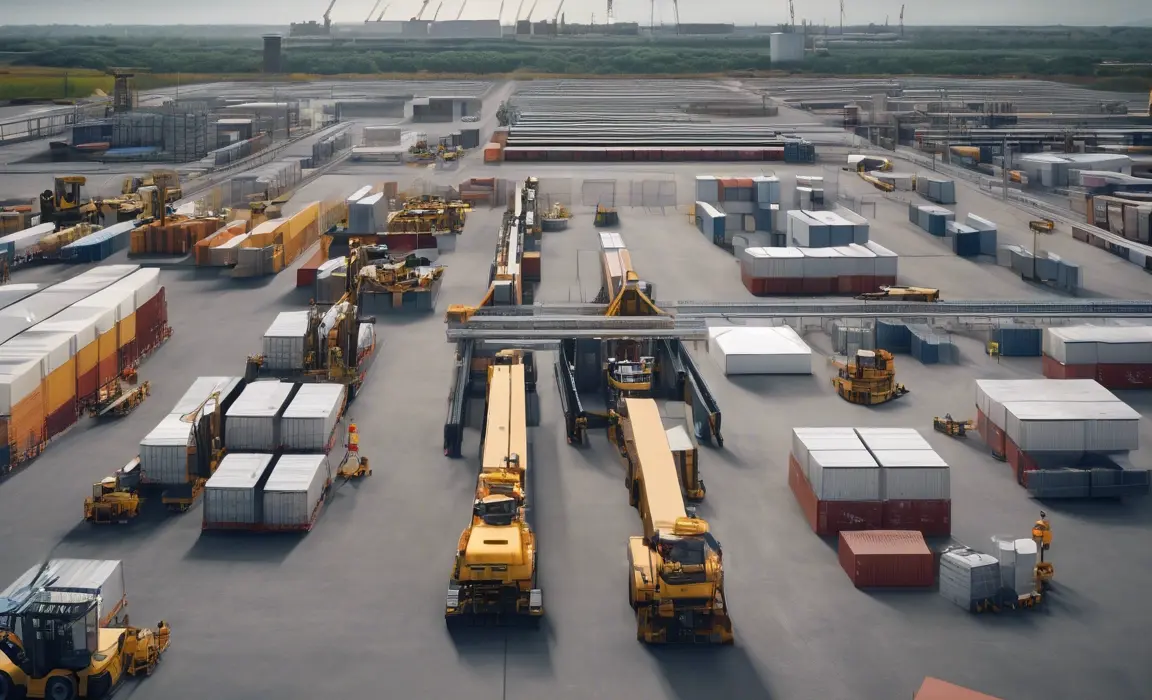Manual yard work still slows down supply chain and logistics operations. Nearly 40% of organizations stick with outdated paper-based processes that raise risks, slow teams, and drive up costs. Automation and real-time yard management systems have shown clear benefits—cutting search times, lowering costs, and reducing safety incidents. Yet, many sites hesitate to upgrade, held back by old systems and concerns about investment.
Key Takeaways
- Manual yard operations cause more workplace accidents, inefficiencies, and lost inventory, hurting both safety and profits.
- Paper-based and manual tracking stretch out trailer search times and dwell times, creating delays that ripple through the supply chain.
- Automation tools—like AI-powered cameras, real-time visibility platforms, and automated gate systems—deliver real cost savings and boost efficiency.
- Common barriers to automation include challenges with integrating old systems, limited understanding of the benefits, and worries about upfront expenses.
- Blending technology with Lean Six Sigma methods and investing in workforce upskilling unlocks lasting gains in efficiency, safety, and competitiveness for modern yard operations.
Why Move Away from Manual Processes?
If your business is still using manual yard operations, you’re risking unnecessary delays, missed opportunities, and increased expenses. Paper-based tracking systems are not only prone to errors but also lead to longer trailer search and dwell times, resulting in costly supply chain disruptions and potential workplace accidents.
The Value of Automation
Embracing automation tools—including AI-powered cameras, real-time yard visibility, and automated gates—can directly address these pain points. These tools help:
- Reduce search times for assets and trailers, leading to faster operations.
- Lower operational costs by minimizing manual labor and paperwork.
- Enhance workplace safety by minimizing hazardous manual activities.
- Improve inventory management and reduce instances of lost assets.
Overcoming Barriers to Automation
- Integration with legacy systems is a common hurdle. Working with experienced partners can smooth this transition.
- Educating stakeholders about automation benefits helps drive adoption.
- Concerns regarding upfront investment are valid, but many solutions show measurable ROI quickly through cost and time savings.
How to Future-Proof Yard Operations
Combining technology with proven methodologies like Lean Six Sigma, and investing in the upskilling of your workforce, can lead to lasting improvements in both efficiency and safety. Modern yard management empowers teams, reduces errors, and gives companies a strong competitive edge in the evolving supply chain landscape.
Act now to move away from manual processes. Embracing automation doesn’t just streamline your operations—it delivers real results and positions your business for long-term success.
Manual yard operations can significantly slow down teams and introduce a range of serious hazards. According to Eurostat’s 2021 figures, there were 3,347 workplace fatalities in the EU, with transportation and storage identified as two of the highest-risk sectors. In my experience, manual tracking systems are often responsible for misplaced trailers and inadequate visibility—both of which directly increase the risk of accidents. Workers are frequently required to operate in unsafe proximity to moving vehicles, especially when visibility is compromised or safety protocols are not rigorously enforced.
Without regular safety audits and robust error-proofing measures, these hazards become even more dangerous. Common problems such as trailer-parking violations, unsecured cargo, and the lack of clearly designated pedestrian pathways not only slow operations but also endanger lives. Statistics show that 68.3% of non-fatal workplace accidents in the EU involve men, reflecting the sector’s workforce demographics and underlining the urgency of addressing these issues.
Key Hazards in Manual Yard Operations
Through years in the industry, I have seen firsthand the variety and severity of threats present in manual yard activities. Below are some of the most pressing risks teams face during manual yard operations:
- Misplaced trailers causing unexpected obstructions
- Poor visibility around vehicles, particularly in low light or confined spaces
- Unsafe interactions between workers and moving equipment
- Unsecured cargo, resulting in shifting loads or falling items
- Trailer-parking violations, creating hazardous zones
- Lack of clear, segregated pedestrian walkways
Modern Solutions for Safer Yards
Addressing these challenges requires proactive safety measures and the adoption of new technologies. The European Car Logistics Association (ECG) has responded with comprehensive Safe Yard Design Guidelines, recommending the segregation of pedestrian routes and the installation of AI-powered cameras to eliminate blind spots.
I strongly recommend deploying AI cameras that provide real-time alerts about unsafe trailer locations. This technology alone can prevent countless incidents. Additionally, platforms like the ECG Incident Reporting Portal enable teams to track near-misses and monitor compliance with safety protocols. By leveraging these modern solutions, teams can proactively identify risks and consistently maintain high safety standards throughout yard operations.

The Persistent Reliance on Manual Yard Processes
Despite the digital transformation reshaping supply chains, manual processes still dominate many yards. According to C3 Solutions’ 2025 State of Yard and Dock Management Report, 39% of organizations continue to use paper and clipboards to manage yard operations. This persistent reliance often stems from legacy systems that seem too entrenched to replace, a lack of understanding about the true benefits of automation, and hesitancy regarding upfront investments.
However, the cost of sticking with manual methods is steep. Searching for a trailer manually can take 45–50 minutes each time, whereas a modern yard management system (YMS) reduces that to just 2 minutes. Sites that have adopted automated YMS have reported impressive gains—first-year savings of $450,000 and reductions in detention fees by as much as $2.5 million.
Why Manual Processes Linger
- Legacy platforms that resist integration with new tech
- Unfamiliarity with the operational and financial gains automation brings
- Initial investment concerns despite significant long-term savings
In Europe, more complex yard layouts and stricter sustainability rules are accelerating the shift toward automation. ABI Research predicts European YMS spending will surpass North America’s by 2028. Solutions such as C3 Solutions YMS and Vector’s real-time orchestration are setting new efficiency benchmarks, offering operational visibility and control that manual systems simply can’t match.

Operational Inefficiencies and Their Ripple Effects
The drawbacks of manual yard work extend far beyond the yard itself, clogging up supply chains from the outset. Trailer dwell times typically stretch 3–4 hours longer than necessary, creating a ripple effect that leads to dock congestion and extends truck turnaround by 20–30%. Manual scheduling and inefficient dock assignment result in trucks sitting idle, driving up costs and inflating idling penalties. In Germany, efforts to reduce the emissions tax have prompted many operators to pilot autonomous yard trucks as a smarter way to keep operations moving.
Inventory management also suffers. About 15% of out-of-stock incidents are due to products sitting unseen in untraceable yard trailers. This not only frustrates inventory managers but also impacts customer satisfaction and bottom-line results.
Fortunately, adopting technology makes a measurable difference. Kaleris YMS automates trailer prioritization based on load urgency, while others leverages RFID tags to reduce check-in times by 75%. These solutions free up resources and keep freight moving, reducing dock congestion and minimizing dwell time and idling penalties. If you’re still relying on manual processes, you’re leaving efficiency—and money—on the table.

Technological Solutions Driving Efficiency
Today, AI and real-time visibility tools are transforming yard operations, eliminating inefficiencies that have persisted for years. I’ve witnessed AI-powered yard systems cut manual audit labor by as much as 80%. These systems don’t just save time—they also boost data accuracy to 99.8%, instilling new confidence in inventory and asset tracking.
Automated yard audits now replace the need for staff to perform 3–4 manual checks daily. This shift enables teams to focus on higher-value activities and make better use of their expertise. Sensors and GPS trackers have made it possible to locate assets quickly, reducing trailer search times by 90%. Real-time orchestration ensures yard and warehouse teams work in harmony, smoothing the flow of goods and reducing friction at every stage.
A real-world example: FM Logistic in France has demonstrated the value of autonomous yard trucks, cutting diesel consumption by 40%. This not only reduces costs but also supports compliance with EU Green Deal targets—a win for both the bottom line and sustainability.
Standout Technologies Making a Difference
- AI analytics: Delivers deep insights for smarter decision-making.
- Predictive maintenance: Catches issues before they disrupt operations.
- Real-time visibility: Keeps everyone informed, reducing response times and bottlenecks.
- AI cameras (like Blue Yonder’s): Monitor trailer conditions, catching problems early.
- Dock scheduling (such as FourKites’): Streamlines workflows, slashing wait times and improving throughput.
Embracing these solutions means leaving behind the frustrations of manual yard work. The benefits are clear—faster operations, lower costs, and teams empowered to drive real growth.

Pairing technology with strong organizational change is the key to transforming yard operations. Integrating Lean Six Sigma methodologies with Yard Management System (YMS) solutions can accelerate process cycles by up to 50% compared to teams that simply install new software without a change strategy. I always recommend mapping your value streams—this approach identifies inefficiencies and can cut redundant labor by 30%, freeing up teams for higher-value work.
Training is equally critical. It illustrates that upskilling staff on new tools can reduce error rates by 25%. When teams are confident using digital tools, they make fewer mistakes and are better equipped to spot opportunities for improvement. Benchmarking against resources like the EU Injury Database encourages organizations to prioritize safety and automation, making operations smoother and reducing costly incidents.
To bridge the gap from manual legacy processes to digital excellence, I focus on three strategies:
- Lean Six Sigma for continuous improvement
- Workforce upskilling initiatives
- Strong change management practices
These approaches deliver the operational agility and efficiency that today’s supply chains demand. By embracing technology, investing in people, and committing to continuous improvement, organizations can transform their yards into safer, more productive, and more resilient operations.
Ready to take your yard operations to the next level? Start exploring modern yard management solutions today and unlock new efficiencies for your team.
Sources:
C3 Solutions – 2025 State of Yard and Dock Management Report
Eurostat – 2021 Workplace Accident Data
European Car Logistics Association (ECG) – Guidelines for Safe Yard Design
ABI Research – Autonomous Yard Trucks and YMS Growth
McKinsey – Resource Allocation Framework
EU Injury Database (IDB) – Methodology










